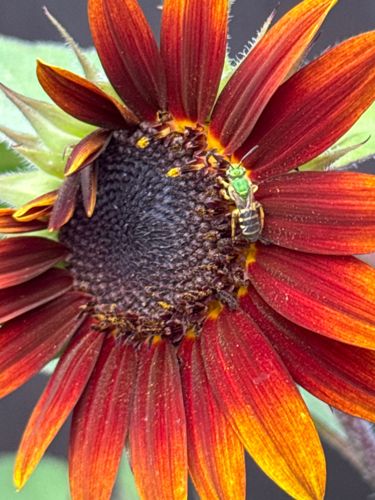Green Sweat Bee (likely a species of Agapostemon or Augochloropsis)
Scientific Name: Likely Agapostemon virescens or a closely related species within the genus Agapostemon or Augochloropsis, exact species identification often requires microscopic examination.
Order & Family: Order: Hymenoptera, Family: Halictidae (Sweat Bees)
Size: Typically 5-15 mm (0.2-0.6 inches) in length, varying by species.

Natural Habitat
They are commonly found in diverse habitats including gardens, meadows, open woodlands, agricultural fields, and urban areas where flowering plants are present and suitable nesting sites (bare or sparsely vegetated soil) are available.
Diet & Feeding
Green sweat bees are generalist pollinators, feeding on nectar for energy and collecting pollen to provision their nests for their larvae. They visit a wide variety of flowering plants.
Behavior Patterns
Green sweat bees are solitary bees, meaning they do not live in colonies with a queen and workers like honey bees. Females typically build individual nests in the ground, often in bare patches of soil, burrowing tunnels where they lay eggs and provision them with pollen and nectar. They are active during the day, foraging for pollen and nectar from a wide variety of flowers. While solitary, multiple females may nest in close proximity, forming aggregations.
Risks & Benefits
Benefits: Green sweat bees are excellent pollinators and contribute significantly to the reproduction of many native plants and agricultural crops. They are beneficial insects that help maintain biodiversity. Risks: They are generally non-aggressive and only sting if provoked or accidentally squashed. Their sting is mild and less potent than that of a honey bee or wasp, often described as similar to a mosquito bite for most people. They are not considered a significant risk to humans.
Identified on: 8/12/2025